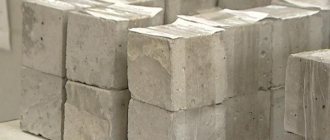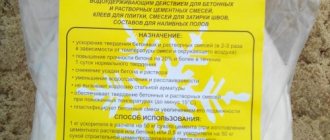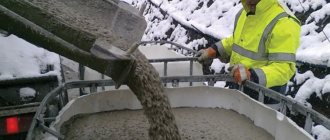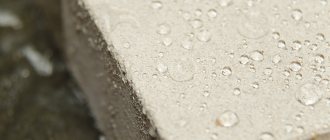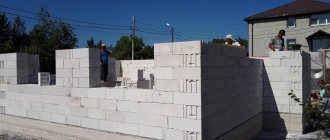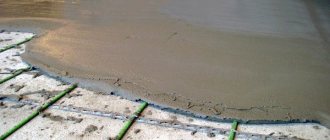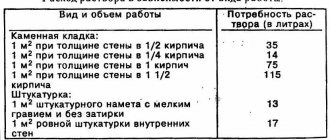Without going into technological details, washed concrete is a material made from cement stone, the surface of which is not smooth, but rocky. Moreover, not ordinary gravel is used for cladding, but pebbles made of granite, marble and other rocks, as well as colored glass or stone inclusions. In other words, the laid mortar, which has not reached the required strength, is eroded in the upper layer, due to which the described effect is obtained. The essence of the technology for creating a washed rocky texture is the stratification of the concrete solution according to the rate of strength gain: a gel hardening retarder is applied to the classic working composition, laid in the formwork. Due to this, the main volume of the structure or product reaches the design state much faster than the surface from which excess mortar is removed.
Review of the most popular cement retarders
Universal polypropylene reinforcing fiber for adding to the solution. Read more
Cold joints are places of reduced strength of concrete, therefore, if necessary, their construction must follow certain rules:
- cold seams are installed in those places whose reduced strength will not negatively affect the strength of the structure;
- the edge of the set concrete before laying a new portion of the mixture must be cleaned until the coarse aggregate is exposed (which is an additional labor-intensive process);
- metal reinforcement is produced in such a way that it intersects the plane of the cold seam.
Of course, it would be nice to be able to avoid additional labor costs, and now, thanks to the achievements of the chemical industry, builders have such an opportunity.
A modern technological solution to the above problems is the use of concrete hardening retarders.
In what other cases are inhibitor additives used?
Retarder additives are air-entraining additives for mortars, so they can be used in the production of lightweight concrete products. Application examples:
- expanded clay concrete;
- perlite concrete;
- polystyrene foam concrete.
Classification of retarders: effect on concrete composition
The most suitable classes for these purposes are the first, second and fourth.
- Additives of the first class are electrolytes that change the solubility of binders. These include amines, organic acids, and alcohols. At the moment they are in less demand.
- Additives of the second class interact with binders, creating poorly soluble or slightly dissociated compounds. The retarding effect of additives of this class can be explained by the appearance of shielding films that are obtained from the reaction products.
- Additives of the fourth class are the most suitable additive option. These include surfactants that can be adsorbed on both binders and hydrate formations. There are two main types of moderators: chemical and physical effects.
The first are based on inhibition of the growth process of the crystal lattice in the mixture. Thanks to its slow growth, the lattice acquires a more complex and uniform appearance, which has a positive effect on the strength of the finished concrete. Among the advantages, one can also note the increased frost resistance and water resistance of the entire structure. But here, as mentioned above, it is necessary to adhere to a strict dosage. An excess of additive in the solution can lead to a critical loss of concrete strength.
The latter form a difficult-to-permeate film on the cement grains themselves, slowing down their setting. This increases adhesion and moisture protection, but has a bad effect on the overall strength of the finished structure.
Instructions for using VARNISH - a hardening retarder for application to the concrete surface
1 . Prepare the concrete mixture. The aggregate can be incorporated into the concrete or applied to the surface separately. 2 . Place the concrete mixture on a previously prepared surface. 3 . Leave until the laitance disappears from the surface (time depends on the W/C grade of concrete, ambient temperature, layer thickness). 4 . If the decorative Filler is applied only to the surface of the concrete, and not introduced into the volume of the entire mixture, it is necessary to wait until the concrete gains the strength of “plasticine” and distribute the Filler evenly over the surface. Then we lay a layer of sand concrete with a W/C >= 0.45 on top and smooth it over with a trowel. We wait until the laitance disappears from the surface (becomes dull). 5 . Using a garden sprayer (without pressure), evenly apply Varnish for surface retardation of concrete hardening, after thoroughly mixing the reagent with a mixer or shaking. The approximate consumption of Varnish is 120 g/m2. 6 . Immediately after applying the varnish, be sure to cover the surface with film to prevent moisture evaporation and protect from precipitation. 7 . Leave until the concrete reaches minimum strength to wash off the unhardened layer. The required time is approximately 12-24 hours (depending on the brand of cement, temperature). 8 . Remove the film. Using a high-pressure washer (or a hose with running water and a nylon brush), wash off the unhardened top layer, exposing the filler. 9 . Cut expansion joints to prevent uncontrolled cracking. 10 . Re-cover the surface with film and leave to gain further strength for a period of 5-7 days. eleven . Seal expansion joints with sealant. 12 . If necessary, perform finishing surface treatment (water repellent, hardening impregnation, concrete varnish with a “wet stone” effect)
Additional surface treatment of products using “washed concrete” technology
Finishing the surface of products and structures using the “washed concrete” technology includes several points that are not mandatory, but will both increase wear resistance and increase aesthetic appeal. Finishing includes:
- Application of strengthening impregnation is a composition that strengthens the top layer of concrete and prevents the loss (especially under load) of partially exposed Aggregate from the surface of washed concrete. This is especially important for monolithic concrete poured onto sites (not into forms) where the top layer is the least durable.
- Hydrophobization is the application of a water-repellent composition to the surface, which reduces moisture absorption by 10-15 times and accordingly increases frost resistance. Hydrophobization of the stone surface is carried out with an organosilicon water-repellent agent (Aquasil) or polymeric hardening impregnations and varnish. Strengthening polymer impregnation or varnish for concrete often combines the functions of a water repellent with other functionality.
- Coating with concrete varnish (for outdoor use) - gives the surface the effect of wet stone and plays a strengthening and protective role. Gives the surface hydrophobic properties. The main purpose is to improve aesthetic properties by enhancing the color of the Aggregate and pigment-painted concrete.
Application area
Most often, such concrete is used to create garden paths and sidewalks, elements of building facades, retaining walls, flower beds, garden benches, and trash cans. Using the material you can make a fence, column, stairs and railings, and various decorative elements. Washed concrete is used to finish parking areas and is widely used in landscape and park design.
Small architectural forms for landscape design
Set retarders: purpose and characteristics
To ensure the solidity of concrete products, it is necessary to ensure a continuous cycle of work. However, this is not possible when the structure is large or when filling complex shapes. Then you have to resort to the method of constructing working seams.
Construction of a monolithic structure using retarders
Such seams are a weak point in any concrete structure. They must be arranged in sections where joints with earlier filling cannot negatively affect the strength of the product as a whole. Besides. the construction of working joints is associated with additional time and labor costs, since high-quality adhesion of old and new concrete requires special processing: cleaning from the cement film to coarse aggregate, washing with a stream of water and blowing with compressed air, or wiping with hard wire brushes.
All these complex and time-consuming work can be avoided if you ensure a continuous concreting process, or take short breaks during which the cement does not have time to set. One of the possible ways to solve the problem is to introduce special retarders into the composition. The process is carried out taking into account the uninterrupted supply of ready-made concrete to the site and the agreed work schedule.
Another important factor in the use of retarders is related to cases where the solution must be transported significant distances to the construction site. In the production of concrete products, additives that retard setting are used when concreting external wall panels in order to have time to open the surface layer and expose the decorative filler after rapid hardening.
Efficiency of concrete set retarders
This type of chemical additives is subject to certain requirements for reliability and efficiency:
- increase in the time of loss of mobility up to 2 cm by 100% or more (at an air temperature of 20±2 °C)
- reduction in structural strength by 30 percent or more within up to 7 days. After 28 days, the strength of the structure should increase, and its permeability should decrease.
Mechanism of action
The mechanism of action of retarders is to inhibit hydration processes and hydrolysis of clinker minerals, that is, to slowly release lime into the mixture and slow down the processes of bringing cement grains together and coagulation. As a result, the intensity of setting of clinker cements mixed in water is significantly reduced.
Dough setting can also be slowed down by using additives that act on the principle of quickly binding free lime, which releases C3S, without interfering with the hydrolysis of clinker minerals and hydration. Individual electrolytes can also act to retard setting, preventing coagulation and the appearance of hydrate formations, depending on their percentage in the solution.
What are retarders made of?
In modern construction practice today, vast experience has been gained in the use of various moderators, both domestic and imported, based on NTP (nitrilotrimethylenephosphonic acid), waste from the sugar and milk processing industries. The influence of all these chemical compositions on the final durability and strength of concrete, depending on their participation in various chemical reactions in the solution, is often unpredictable. Therefore, there is only one way to achieve efficiency - to determine the amount of additives required experimentally, testing the strength during compression and complying with current regulatory requirements.
How do hardening retarders work?
Additives for retarding the setting and hardening of concrete inhibit the hydration processes of clinker minerals, and also contain electrolytes that prevent the coagulation of colloidal solution and hydrate compounds.
Classification of concrete hardening retarders according to the principle of action
There are two main types of concrete hardening retarders
Physical hardening retarders
These additives create a film on the surface of the cement grain, preventing hydration. The disadvantage of such additives is a possible decrease in the strength of concrete.
Chemical additives
When used in recommended concentrations, they do not affect the final strength of concrete. They slow down the natural growth of the crystalline structure of concrete, as a result of which it is formed more evenly, and this ultimately has a positive effect on the strength of the material.
The criterion for the retarder to work is to reduce the strength of concrete by 30% at the age of up to one week without reducing the strength at the age of four weeks.
The following substances are also used as hardening retarders:
- whey (1.5–3% by weight of concrete);
- feed sugar molasses (0.05–0.3% by weight of cement);
- bone glue;
- starch.
There are certain restrictions in the use of these additives; for example, sugar molasses is not suitable for reinforced concrete structures.
Equipment and materials
For production you must have the following equipment:
- concrete mixer;
- vibrating table;
- water pump.
Instead of a water pump, you can use a portable car wash. It is more convenient because the jet pressure and its width can be adjusted.
The main raw materials for production are:
- water;
- sand;
- cement M400;
- plasticizers;
- hardening retarders.
As a filler, it is necessary to use materials with a dense surface:
- marble or granite chips:
- colored pebbles.
When using a filler made of porous materials, cement laitance may penetrate into the pores, which will then be difficult or even impossible to remove.
Advice: during preparatory work, before filling the mold with your own hands, apply gel for washed concrete (deactivator) to its walls: with a spray gun, roller or brush.
Retarders for setting and hardening of concrete
These additives are used in the construction of facilities where it is impossible to ensure a continuous supply of mortar over long distances from the concrete unit to the construction site. Additives reduce not only the setting time, but at the same time the strength for the duration of their action. Therefore, after a day, the technology provides for their washing away under the pressure of water. In industrial construction, retarders are used:
- Nitrilotrimethylenephosphonic acid;
- RSB-500;
- Feed sugar molasses;
- Milk serum;
- Addition VZ 2;
- Peramin R;
- Pozzolit 100-XR;
- Sementol Retard;
- Zika Retard;
- Sodium gluconate.
The deactivator penetrates the surface layer that holds stone pebbles to a depth of 10 mm.
Please note: the amount of retarder is calculated based on the weight of the cement, not the total volume of concrete.
Set retarders and anti-frost additives for concrete
Some retardation of setting may be useful for monolithic concrete: during long-term transportation of the mixture or when there are interruptions in its installation. In some cases, it allows one to avoid working concreting joints. Retarders can also be used when concreting in hot weather. Known retarders are sugars (glucose, fructose, etc.), feed sugar molasses, and crude ligno-sulfonates (containing sugars). Other additives are also used (citric acid, sodium gluconate, etc.). Some plasticizing additives also slow down the setting of concrete (for example, lignosulfonates). The dosages of set retarders are small: 0.1-0.15% by weight of cement, and the effect, regulated by the consumption of the additive, can be very significant: retardation of set from several hours to several days, and in case of overdose - generally for an indefinite time. Even a limited slowdown in the hydration of cement in a concrete mixture usually extends to the hardening of concrete, causing a smaller increase in strength at an early age. The effect of additives - retarders, like many other additives, depends on the characteristics of the cement, the temperature of the mixture and a number of other factors, so their dosage should be determine in experiment. This takes into account not only the retardation of setting, but also the effect of additives on the hardening kinetics of concrete. According to GOST, these additives should ensure a retardation of concrete setting by 30% or more, with a decrease in strength at the age of 28 days by no more than 5%.
Retarder additives can also be used in case of sudden delays in the delivery or placement of concrete mixture. The driver of the concrete mixer truck should have with him a solution of the retarder additive and data on the relationship between the dosage and the retarding effect.
The use of anti-frost additives is one of the winter concreting techniques. It can be carried out separately or in combination with other techniques (thermos method or various methods of additional heat supply to molded concrete). In the latter case, the role of antifreeze additives is limited to protecting the concrete mixture from freezing during its delivery and placement. The physical basis for the use of antifreeze additives is to reduce the freezing point of water when salt is dissolved in it. In a simplified way, we can imagine that salt ions “interfere” with the formation of the crystal lattice of ice when the water temperature decreases. Therefore, the higher the concentration of the solution, the lower its freezing temperature. The decrease in freezing temperature reaches -21 ° C (at a solution concentration of 23%). Having determined the maximum negative temperature at which the concrete mixture should not freeze, the required solution concentration for this is found from the diagram. In this case, it is better to calculate the additive as a percentage of the mixing water. This gives more reliable results, since it is the concentration of salt in the water that determines the freezing point. In practice, cement additives (especially complex ones) are more often referred to as additives. It should be taken into account that the higher the W/C of the mixture, the lower the salt concentration in the water and the higher the freezing point of the mixture. Basically the same salts that are used to accelerate the hardening of concrete are used as antifreeze additives. Considering the restrictions on the use of chloride salts, the main trend in this area is the use of chloride-free additives. Antifreeze additives are used, as a rule, in the form of complexes. In particular, their combination with plasticizers will reduce the W/C and further accelerate the hardening of concrete, which is especially important during winter concreting.
GOST provides two options for using antifreeze additives:
- for “cold” concrete and mortar: ensuring hardening at low temperatures. In this case, the additives should provide, before freezing the concrete, depending on its class, a set of 30-50% of the 28-day strength of control concrete of normal hardening;
- for “warm” concrete and mortar: ensuring the mixtures are protected from freezing for the period from production to installation and supply of external heat. In this case, a set of at least 95% of the 28-day strength of the control concrete of normal hardening must be ensured.
It should be noted that antifreeze additives not only protect the mixture from freezing, but also ensure its hardening at subzero temperatures. But the hardening speed is quite low.
Use of retarders
Set retarders are additives that increase the hardening time of alabaster . They are divided into organic and inorganic. Here is a complete list of moderators, the use of which has been confirmed in practice:
- PVA,
- Wallpaper glue,
- Dishwashing liquid (Ferry),
- Liquid soap,
- Boric and citric acid,
- Washing powder,
- Putty Vetonit,
- Milk 3.2 fat content,
- Concrete plasticizer.
Making washed concrete with your own hands at home
Making washed concrete with your own hands at home is not very difficult; this technology can be implemented on the territory of a country house.
The step-by-step process is as follows:
- Take cement, sand, filler (gravel, pebbles, crushed stone 2-5 mm in size) in a ratio of 1:1.5:1. You can take more filler, up to three parts, it depends on what appearance you want to achieve.
- The materials are loaded into a concrete mixer: in it you can mix all the components evenly and make small batches. The result should be a creamy consistency.
Important! To obtain a homogeneous mass, water is added to the dry components - up to half the volume of cement.
- Construction forms are placed on a vibrating table, a gel is applied to the bottom or paper is lined with reagents that slow down the setting of concrete.
- The containers are filled with the finished mass and vibration is started to compact the solution.
- When the bottom layer of concrete has set, the form is removed. The hardening time for small objects is about a day, for large ones – up to two days.
- The top layer is washed with a powerful stream of water, removing the gel. To wash the maximum amount of solution, the stream is directed at an angle.
Important! If the gel is difficult to wash out, you can use a sponge or a brush with soft bristles.
For the construction of large objects or pouring a monolithic slab, wooden formwork is installed. It is also lined with deactivator paper or treated with gel. After the central part of the decor has hardened, the formwork is removed and the mass is washed from the outside of the product.
Great importance is given to the optimal hardening time. Premature removal of the formwork or removal of the object from the mold will lead to too much leaching of decorative elements from the surface. And vice versa: if you overexpose the object, you will not be able to expose the filler to the required depth.
Important! Experts recommend conducting a test on a sample to find out the hardening time of a particular batch of mortar.
If the finished surface will be actively used (for example, it is paving slabs, a platform or a path), then it is coated with a finishing agent that prevents crumbling of the aggregate and increases the service life of the landscape element. There are three main types of processing you can find in stores:
- Strengthening impregnation - it binds and strengthens pebbles, crushed stone, gravel and other aggregates that become exposed when washed and can spill out.
- Concrete varnish (during outdoor work) – creates the effect of wet stone on the surface. The varnish imparts hydrophobic properties to the filler and also plays a strengthening role.
- Composition for enhanced moisture protection of the finished object. Thanks to chemical additives, the product reduces liquid absorption by 10-15 times. That is, during temperature changes, moisture will not solidify in the depressions of the relief and damage the strength of the outer layer.
What you need
To make washed concrete, we need the same components as for regular concrete, but there are a few nuances.
A rough surface is obtained as follows: lay concrete as usual, and then wash out the thin top layer of cement-sand mortar so that the stones are partially exposed. This cannot be done without a special deactivator, which slows down the setting. They are available in the form of varnishes and gels.
The product is applied after laying and penetrates to a given thickness (0.5-0.8 mm), so that the primary hardening slows down only in the top layer. The rest of the concrete dries at a normal speed, gaining strength. The weak layer that has not hardened can be easily removed with a stream of water. Everything underneath remains intact.
The gel consumption will be about 90-180 g/m2, and the varnish will be 180 g/m2.
When making paving slabs, the retarder is applied to the bottom of the mold. They are washed after stripping.
It turns out that for work we will need:
- concrete hardening retarder;
- spray or wide brush to apply retarder;
- a water pump with a sprayer or a compressor (pressure no more than 0.5 MPa, so as not to damage the top layer during the flushing process);
- formwork (forms) for washed concrete;
- laying paper for the form;
- container for solution;
- concrete mixer;
- installation tools - shovel, trowel, spatula.
Well, the composition is standard:
- water;
- cement;
- sand;
- coarse aggregate (5-20 mm).
The cement must be grade M400 and higher. Any filler is suitable: crushed stone, pebbles, dolomite, quartzite, marble and granite chips.
How can you influence the setting speed?
The setting speed affects the quality of the concrete mixture. Any deviation from the standards negatively affects strength and durability.
How to slow down the setting of concrete
It is necessary to delay setting in the following cases:
- When pouring concrete in hot weather.
- When transporting concrete mixture over long distances.
- When there is difficult, heavy traffic on the roads, when the concrete mixer truck has to stand in traffic jams for a long time.
- When pouring concrete in stages, so that the mixture remains in its original state for a long time.
With the help of retarders, it is possible to postpone the chemical reaction between cement grains and water for several hours, from 48 to 72. At the same time, the properties of the concrete mixture are preserved, including strength and durability. The following concrete retarders are used:
- Linamix;
- Polyplast Retard;
- Sika Retarder.
What you need
To make decorative building material you will need:
- water;
- sand (any);
- aggregate with a fraction of 5 to 20 mm (crushed stone, granite chips, marble, dolomite);
- cement (grade M 400 and higher);
- concrete mix retarder (Peramin R, G-05, Cementol Retarde or any other);
- container for mixing the solution;
- a water pump or a spray gun with a compressor (to make a path for a suburban area, a regular pump for whitewashing will be sufficient);
- ready-made plastic or homemade wooden forms;
- concrete mixer;
- vibration table (preferably);
- sprayer for applying retarder.
Healthy! If you intend to prepare a solution for a large structure, then it is better to use an inertial concrete mixer (“pear” will not work). To prepare a small volume of the mixture, you can mix concrete by hand.
Healthy! The expensive gel hardener can be replaced with regular sugar syrup or detergent.
Having prepared everything you need, you can start working.


